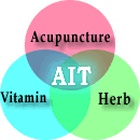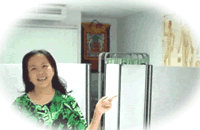Cardiac
artery disease
A
heart specialist had told me that I was very close to death. Those comments
did not disturb me, but only made my eardrums ache when I was notified
of the charges/costs for me to follow up by merely undergoing further
tests.
At a leading hospital, where I visited for a routine check-up, I was
told that I have an "abnormal" heart. I was then examined,
x-rayed and made to undergo various tests to ascertain the extent of
the damage to my heart. The final analysis was that my heart was 80%
dead.
With only 20% of my heart working, my days were numbered and I was told
to undergo further tests, and thereafter medication, to try and re-build
the dead areas. This would have cost me a fortune just to make an assessment
of what needed to be done.
After the tests and the analysis by the Doctor, I returned home with
my ears full of a new episode in life. But I decided to keep the story
to myself and not take the comments of the Doctor so seriously, but
rather to lead a normal life -- I mean a life full of fun and activity,
the same as always.
I tried AIT at the recommendation of a good friend of mine where she
explained in detail the type of treatment she would administer to me.
I agreed to go through the process, because it was Chinese acupuncture
treatment, combined with injected herbal medication, which I knew would
not do any harm to my already "broken heart".
Initially, I tried AIT for 7 days running and thereafter weekly. I felt
I was becoming stronger each day and I was already feeling a lot better
than when I started.
I continued AIT for almost 10 months and embarked on a fitness program
where I did some light workouts and a little bit of everything in the
way of exercise.
Now, almost a year and a half have passed since I visited any Doctor
or underwent any checks or tests. I am now on a heavy weight-training
program where I do a lot of strenuous exercises three times a week.
I am now feeling much stronger in my twilight years.
I take this opportunity to recommend to anyone who learns of this episode
to consult AIT, whether it is for a heart ailment or for any illness
that has bothered you so much as mine.
Thanks to AIT so much giving me a new lease on life.
.
Best Regards as always,
Ex-Heart Patient
DOCTOR'
S COMMENTS:
CORONARY
ARTERY DISEASE (CAD)
The coronary arteries supply the heart with oxygen-rich blood. In order
to perform the arduous task of pumping blood, the heart muscle needs
a plentiful supply of oxygen-rich blood, which is provided through a
network of coronary arteries. Coronary Artery Disease (CAD) is the end
result of atherosclerosis (hardening of the arteries), a process in
which the arteries narrow because fatty deposits, called plaques, build
up inside the coronary arteries. When the arteries narrow, less oxygen-rich
blood flows to the heart. This lack of sufficient oxygen to the heart
may cause angina or a heart attack. Oxygen deprivation in vital cells
(called ischemia) causes injury to the tissues of the heart. If the
artery becomes completely blocked, damage becomes so extensive that
cell death, called infarction (a heart attack), occurs.
Atherosclerosis is triggered by excess amounts of unstable particles
known as oxygen-free radicals, which bind with and alter other molecules
(a process called oxidation). The particles are released as part of
normal bodily processes. However, environmental toxins such as viruses
or smoking can produce excessive amounts of these particles. When free
radicals are released in artery linings, they react with and oxidize
low-density lipoproteins (LDL, the so-called " bad cholesterol"
). LDL then deposits mushy layers of oxidized cholesterol on the walls
of the artery. The cholesterol accumulates and eventually hardens into
plaques. But that isn't the end of the story. The injuries to the arteries
signal the immune system to release white blood cells (particularly
those called neutrophils and macrophages) at the site. This initiates
a process called the inflammatory response. Macrophages literally "eat"
foreign debris (in this case oxidized cholesterol) and become foamy
cells that attach to smooth muscle cells causing them to build up. The
immune system, sensing further harm, releases other factors called cytokines,
which attract more white blood cells and perpetuate the whole cycle.
They also stimulate the liver to produce blood-clotting factors called
fibrinogen and C-reactive proteins. Injured inner walls fail to produce
enough nitric oxide, a substance critical for maintaining blood vessel
elasticity. The arteries become calcified and lose elasticity. As this
process continues, blood flow slows. A heart attack usually occurs when
a blood clot forms, completely sealing off the passage of blood. This
typically happens when the plaque itself develops fissures or tears.
Then blood platelets adhere to the site to seal off the plaque and a
blood clot (thrombus) forms.
ANGINA
Angina is not a disease itself but is the primary symptom of coronary
artery disease. It is typically experienced as chest pain, which can
be mild, moderate, or severe. But it is often reported as a dull, heavy
pressure that may resemble a crushing object on the chest. Pain often
radiates to the neck, jaw, or left shoulder and arm. Less commonly,
patients report a mild burning chest discomfort, sharp chest pain, or
pain that radiates to the right arm or the back. Sometimes a patient
experiences shortness of breath, fatigue, or palpitations instead of
pain. Classic angina is precipitated by exertion, stress, or exposure
to cold, and is relieved by rest or nitroglycerin. Angina can also be
precipitated by large meals, which place an immediate demand upon the
heart for more oxygen. The intensity of the pain does not always relate
to the severity of the medical problem. Some people may feel a crushing
pain from mild ischemia, while others might experience only mild discomfort
from severe ischemia. Some people have also reported a higher sensitivity
to heat on the skin with the onset of angina.
Although atherosclerosis is far and away the leading cause of angina,
other conditions can impair the delivery of oxygen to the heart muscle
and cause pain. Such conditions include:
1. Spasm in the coronary artery
2. Abnormalities of the heart muscle itself
3. Hyperthyroidism
4. Anemia
5. Vasculitis (a group of disorders that cause inflammation of the blood
vessels) and, in rare cases
6. Exposure to high altitudes
Many conditions may cause chest pains unrelated to heart or blood vessel
abnormalities. High on the list are:
1. Anxiety attacks
2. Gastrointestinal disorders (gallstone attacks, peptic ulcer disease,
hiatal hernia, heartburn)
3. Lung disorders (asthma, blood clots, bronchitis, pneumonia, collapsed
lung)
4. Problems affecting the ribs and chest muscles (injured muscles, fractures,
arthritis, spasms, infections).
STABLE
ANGINA: Stable angina can be extremely painful, but its occurrence is
predictable. It is usually triggered by exertion or stress and relieved
by rest. Stable angina responds well to medical treatment. Any event
that increases oxygen demand can cause angina, including exercise, cold
weather, emotional tension, and even large meals. Angina attacks can
occur at any time during the day, but a high proportion seems to take
place between the hours of 6:00 AM and noon.
UNSTABLE ANGINA: Unstable angina is a much more serious situation and
is often an intermediate stage between stable angina and a heart attack.
A patient is usually diagnosed with unstable angina under the following
conditions; a) pain awakens a patient or occurs during rest, or b) a
patient who has never experienced angina has severe or moderate pain
during mild exertion (walking two level blocks or climbing one flight
of stairs), or c) stable angina has progressed in severity and frequency
within a two-month period. Medications are less effective in relieving
the pain of unstable angina.
PRINZMETAL'S ANGINA: A third type of angina, called "variant"
or Prinzmetal's angina, is caused by the spasm of a coronary artery.
It almost always occurs when the patient is at rest. Irregular heartbeats
are common, but the pain is generally relieved immediately with treatment.
SILENT
ISCHEMIA
Some people with severe CAD do not experience angina pain (a condition
known as silent ischemia), which some experts attribute to heart pain
being abnormally processed by the brain.
HOW
SERIOUS ARE ANGINA AND CORONARY ARTERY DISEASE (CAD)?
In America, CAD is the leading killer of both men and women -- responsible
for over 475,000 deaths in 1996. On the positive side, mortality rates
from CAD have significantly declined in industrialized countries over
the past few decades, although they are on the rise in developing nations.
When the necessary life style changes are enacted, in combination with
appropriate medical or surgical treatments, a person suffering from
angina and heart disease has a good chance of living a normal life.
For example, experts believe that unstable angina normally indicates
a very high risk for death after a heart attack -- but a recent study
indicated that, after the first year of treatment, such a patient's
risk for death is only 1.2% above the risk in the non-CAD population.
In fact, the onset of angina less than 48 hours before a heart attack
is actually protective -- possibly by conditioning the heart to resist
the damage resulting from the attack. In one study, people without chest
pain experienced much higher complication and mortality rates than those
with pain.
INDICATIONS
OF A HEART ATTACK
1. If angina does not clear up when medication is taken, it is a signal
to go to the hospital.
2. The pain before a heart attack is unexpected, worse than any experienced,
and lasts longer than 20 minutes.
3. The degree of pain indicating a possible heart attack varies greatly
between individuals. So, early-warning symptoms for a heart attack may
be overlooked, because they are mild or may not even occur.
4. Sweating, a feeling of indigestion or heartburn, nausea and vomiting
are common.
5. Some people report a great fear of impending death -- a phenomena
known as angor animi.
6. Women are more likely than men to be nauseous and experience pain
high in the abdomen or chest.
7. The first symptom may be extreme fatigue after physical activity
rather than chest pain.
8. Because chest pain in men is more apt to signal a heart attack, while
chest pain in women is more likely to be caused by other problems, it
should be noted that physicians might not be as alert to a heart problem
when a woman complains of chest pain.
Any chest pain should always be taken seriously. The patient should
chew an aspirin and be sure that emergency health providers are informed
of this so an additional dose of aspirin isn't given. Chest pain sufferers
should go immediately to the nearest emergency room, preferably traveling
by ambulance. They should not drive themselves.
ACUPOINT
INJECTION THERAPY (AIT) FOR CAD:
Chinese herbs (such as Shen Mai, Dan Shen, etc. to improve the heart
muscle function) and Vitamins (such as Vitamin C as an antioxidant)
are directly injected into specific acupuncture points (NOTE: we must
differentiate the diagnose first, then select suitable acupuncture points
to treat the patient).
THE BENEFITS:
1. Balancing the Yin and Yang. The deficiency is adjusted to improve
all the functions of the body's organs, in order to reduce the cholesterol
level (especially LDL). The fatty deposits inside the coronary arteries
will be reduced which slow down the atherosclerosis process and improve
the blood flow.
2. Improving blood supply to the heart while increasing Oxygen and nutrition
intake to the myocardiam to improve heart function. At the same time
blood circulation is improved and can absorb the extra fatty deposits
and soften the arteries.
3. Improving the liver and kidney functions to detoxify the body while
balancing the immune system and generally improving the body's condition
in order to reduce the causes of this disease.


